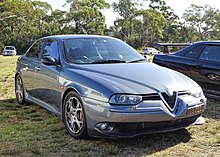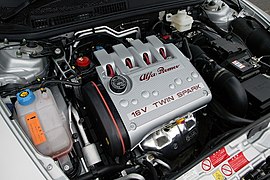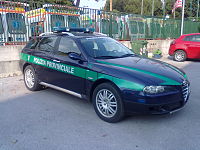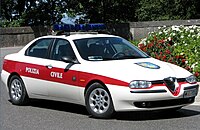
Maserati S.p.A. is an Italian luxury vehicle manufacturer. Established on 1 December 1914 in Bologna, Italy, the company's headquarters are now in Modena, and its emblem is a trident. The company has been owned by Stellantis since 2021. Maserati was initially associated with Ferrari. In May 2014, due to ambitious plans and product launches, Maserati sold a record of over 3,000 cars in one month. This caused them to increase production of the Quattroporte and Ghibli models. In addition to the Ghibli and Quattroporte, Maserati offers the Maserati GranTurismo and two SUV models, the Maserati Levante and the Maserati Grecale. Maserati has placed a yearly production output cap at 75,000 vehicles globally.
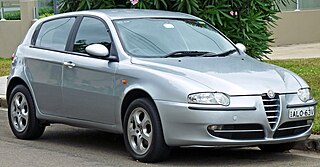
The Alfa Romeo 147 is a small family car produced by the Italian automaker Alfa Romeo from 2000 to 2010. The 147 was voted European Car of the Year in 2001.

The Alfa Romeo 164 is a four-door executive saloon manufactured and marketed by Italian automaker Alfa Romeo from 1987 to 1998, styled by Pininfarina, and cooperatively designed and sharing platforms and numerous elements with the Fiat Croma, Saab 9000 and Lancia Thema.

The Alfa Romeo 155 is a compact executive car produced by Italian automobile manufacturer Alfa Romeo between 1992 and 1998. It was unveiled in January 1992 at Barcelona, with the first public launch in March 1992, at the Geneva Motor Show. A total of 195,526 units were made before it was replaced by the 156.

The Alfa Romeo Brera and the Alfa Romeo Spider are mid-size sports cars using the GM/Fiat Premium platform, manufactured by Pininfarina and marketed by Alfa Romeo as a 2+2 coupé and roadster respectively.

The Alfa Romeo 159 is a car built by Italian marque Alfa Romeo between 2004 and 2011. It is a large family car in the compact-executive market segment with four-door saloon and five-door estate variants. Introduced at the 2005 Geneva Motor Show, as a replacement for the 156, the 159 used the GM/Fiat Premium platform, shared with the Alfa Romeo Brera and Spider as well as the Kamal and Visconti concept cars.

The Alfa Romeo 75, sold in North America as the Milano, is a compact executive car produced by the Italian automaker Alfa Romeo between 1985 and 1992. The Alfa 75 was commercially quite successful: in only three years, 236,907 cars were produced, and by the end of production in 1992, around 386,767 had been built.
Multijet is Stellantis's term for its current common rail direct injection turbodiesel engine range. Most of the Fiat, Alfa Romeo, and Lancia range, as well as certain Chrysler, RAM Trucks, Jeep, and Maserati vehicles, are equipped with Multijet engines. Ownership of some Fiat Multijet designs is shared with General Motors as part of a settlement of the failed merger between the two auto conglomerates. The GM Powertrain Torino group in Turin, Italy, manages its interest in these engines. Some PSA Peugeot Citroën diesel engines are also rebadged JTD units, and vice versa. Fiat's common-rail diesel engine is also known as JTD, an initialism of Jet Turbo Diesel.

The Alfa Romeo GTV and the Alfa Romeo Spider were sports cars produced by the Italian manufacturer Alfa Romeo from 1993 to 2004. The GTV is a 2+2 coupé, and the Spider is a two-seater roadster version of the GTV. Around 39,000 Spiders and 41,700 GTVs were built.

The Alfa Romeo GT is a coupe automobile that was produced by the Italian automaker Alfa Romeo between 2003 and 2010. The GT was introduced in March 2003 at the Geneva Motor Show. Production started on 28 November 2003 at the Pomigliano d'Arco plant, which the GT shared the assembly plant with the 147 and 159. A total of 80,832 units were produced.
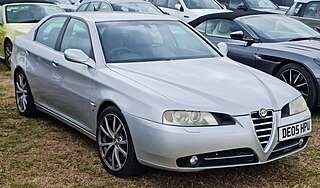
The Alfa Romeo 166 is an executive car produced by the Italian automaker Alfa Romeo, between 1996 and June 2007. The car was designed by Centro Stile Alfa Romeo, under the control of Walter de Silva, and was facelifted in September 2003.

The Alfa Romeo GTA is a coupé automobile manufactured by the Italian manufacturer Alfa Romeo from 1965 to 1971. It was made for racing (Corsa) and road use (Stradale).

The Alfa Romeo Alfetta is a front-engine, five-passenger sedan and fastback coupé manufactured and marketed by Alfa Romeo from 1972 to 1987 with a production total over 400,000.

The Alfa Romeo Twin Cam engine is an all-alloy inline-four engine series produced by Alfa Romeo from 1954 to 1994. In Italian it is known as the "bialbero" ("twin-shaft"), and has also been nicknamed the "Nord" (North) engine in reference to its being built in Portello, Milan, in the North of Italy and to distinguish it from the Alfa Romeo Boxer engine built in the South (Sud) for the Alfasud.

The JTS engine is a gasoline direct injection engine produced by Alfa Romeo. It exists in two forms, straight-4 and V6, and was introduced into the Alfa lineup in 2002.

The Alfa Romeo V6 engine is a 60° V6 engine made by Alfa Romeo from 1979 to 2005. It was developed in the early 1970s by Giuseppe Busso, and first used on the Alfa 6 with a displacement of 2.5 L (2,492 cc) and a SOHC 12-valve cylinder head. Later versions ranged from 1,996 to 3,179 cc and had DOHC 24-valve valvetrains. The original design had short pushrods for the exhaust valves in a design similar to earlier Lancia Fulvia engines. The first DOHC version was in the 1993 Alfa Romeo 164, with an aluminium alloy engine block and head with sodium filled exhaust valves.
Alfa Corse is Alfa Romeo's factory racing team. Throughout the years, Alfa Corse has competed in various forms of motorsport, from Grand Prix motor racing to touring car racing.

The Alfa Romeo MiTo is a front-wheel drive, three-door supermini designed by Centro Stile Alfa Romeo and presented in 2008 at Castello Sforzesco in Milan with an international introduction at the British Motor Show in 2008. The MiTo was marketed across a single generation from 2008 to 2018, sharing the Fiat Small platform with the Fiat Grande Punto. Production reached 293,428 at FCA's Mirafiori plant.
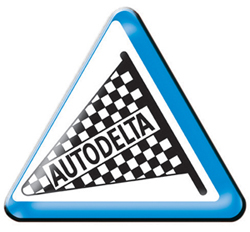
Autodelta SpA was the name of Alfa Romeo's competition department. Established in 1961 as Auto-Delta by Carlo Chiti and Lodovico Chizzola, former Alfa Romeo and Ferrari engineers, the company was officially made a department of Alfa Romeo on March 5, 1963 by the then president of Alfa Romeo Giuseppe Luraghi. Originally based in Feletto Umberto, Udine, the team subsequently moved closer to Alfa Romeo's facilities in Settimo Milanese in 1964, officially becoming Autodelta SpA. The move enabled Autodelta to use the Balocco test track for new racing cars and prototypes.

The Alfa Romeo Giulia is a compact executive car produced by the Italian manufacturer Alfa Romeo. Known internally as the Type 952, it was unveiled in June 2015, with market launch scheduled for February 2016, and it is the first saloon offered by Alfa Romeo after the production of the 159 ended in 2011. The Giulia is also the first mass-market Alfa Romeo vehicle in over two decades to use a longitudinal rear-wheel drive platform, since the 75 which was discontinued in 1992. The Giulia was second in 2017 European Car of the Year voting and was named Motor Trend Car of the Year for 2018. In 2018, Giulia was awarded the Compasso d'Oro industrial design award.









